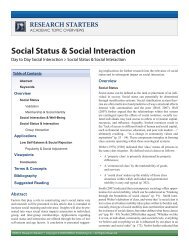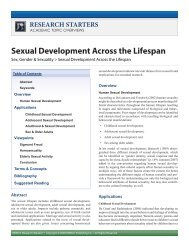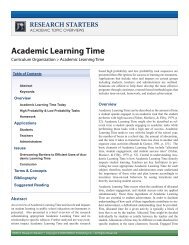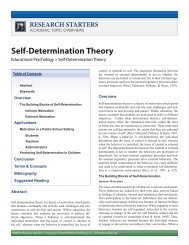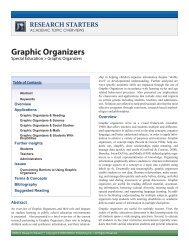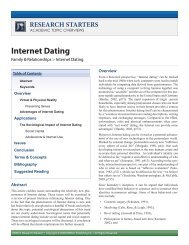Theory of Mind - Link Autism Leadership
Theory of Mind - Link Autism Leadership
Theory of Mind - Link Autism Leadership
Create successful ePaper yourself
Turn your PDF publications into a flip-book with our unique Google optimized e-Paper software.
RESEARCH STARTERS<br />
ACADEMIC TOPIC OVERVIEWS<br />
<strong>Theory</strong> <strong>of</strong> <strong>Mind</strong><br />
Educational Psychology > <strong>Theory</strong> <strong>of</strong> <strong>Mind</strong><br />
Table <strong>of</strong> Contents<br />
Abstract<br />
Abstract<br />
Keywords<br />
Overview<br />
<strong>Theory</strong> <strong>of</strong> <strong>Mind</strong> in Young Children<br />
Hindsight Bias<br />
The Role <strong>of</strong> Deception<br />
<strong>Theory</strong> <strong>of</strong> <strong>Mind</strong> & Social Skills<br />
Applications<br />
Students<br />
Teachers<br />
Administrators<br />
Issues<br />
Overcoming Barriers to Understanding<br />
<strong>Theory</strong> <strong>of</strong> <strong>Mind</strong><br />
Conclusion<br />
Terms & Concepts<br />
Bibliography<br />
Suggested Reading<br />
An overview <strong>of</strong> <strong>Theory</strong> <strong>of</strong> <strong>Mind</strong> and its role and impacts on<br />
student learning in public school education environments is presented.<br />
Also presented is a brief look at the current research<br />
pertaining to <strong>Theory</strong> <strong>of</strong> <strong>Mind</strong> and its relationship to children<br />
and their developmental processes. Further analyzed are ways<br />
social skills are impacted by <strong>Theory</strong> <strong>of</strong> <strong>Mind</strong> in accordance with<br />
age related behavioral processes. Further presented are implications<br />
for classrooms and applications are described that include<br />
roles and impacts on certain groups including students, teachers,<br />
and administrators. Solutions are <strong>of</strong>fered to help pr<strong>of</strong>essionals<br />
develop the most effective programs through consistent, research<br />
based methodologies and philosophies.<br />
Overview<br />
<strong>Theory</strong> <strong>of</strong> <strong>Mind</strong> (ToM) is the term given to “the human ability<br />
to infer the intentions <strong>of</strong> others and to understand that their<br />
actions are guided by beliefs about the world” (Mizrahi, Korostil,<br />
Starkstein, Zipursky, & Shitij, 2007). <strong>Theory</strong> <strong>of</strong> <strong>Mind</strong> can<br />
also be described as “the ability to understand and reason about<br />
[a child’s] own and others’ mental states (such as understanding<br />
that the mind can misrepresent reality)” (Birch & Bernstein,<br />
2007, p. 99). According to McHugh, Barnes-Holmes, Barnes-<br />
Holmes, Stewart, & Dymond (2007), an individual’s “knowledge<br />
<strong>of</strong> informational states in the self and others develops across<br />
five levels originating from simple visual perspective taking to<br />
understanding true and false beliefs” (p. 518).<br />
The first three levels <strong>of</strong> <strong>Theory</strong> <strong>of</strong> <strong>Mind</strong> consist <strong>of</strong><br />
• Simple visual perspective taking,<br />
• Complex visual perspective taking, and<br />
• Applying information based on the principle <strong>of</strong> seeing<br />
leads to knowing.<br />
Levels 4 and 5 <strong>of</strong> this framework “consist <strong>of</strong> the development <strong>of</strong><br />
understanding true and false beliefs. According to this model, the<br />
skills <strong>of</strong> perspective-taking are believed to be essential prerequisites<br />
for the development <strong>of</strong> true and false beliefs” (McHugh, et<br />
al., 2007, p. 518). The study <strong>of</strong> the <strong>Theory</strong> <strong>of</strong> <strong>Mind</strong> is a relatively<br />
new area <strong>of</strong> brain research. Findings from these studies are leading<br />
educators to better understanding developmental processes <strong>of</strong><br />
children in new and expanded ways. This paper seeks to outline<br />
research, practice, and implications for educational pr<strong>of</strong>essionals<br />
and psychologists seeking to better understand how brain development<br />
impacts student thinking and behavior.<br />
EBSCO Research Starters ® • Copyright © 2008 EBSCO Publishing Inc. • All Rights Reserved
<strong>Theory</strong> <strong>of</strong> <strong>Mind</strong><br />
Essay by Sharon <strong>Link</strong>, Ph.D.<br />
Keywords<br />
Emotion Understanding<br />
False Belief<br />
Prefrontal Cortex<br />
Self Awareness<br />
<strong>Theory</strong> <strong>of</strong> <strong>Mind</strong> (ToM)<br />
<strong>Theory</strong> <strong>of</strong> <strong>Mind</strong> in Young Children<br />
One <strong>of</strong> the findings from research is that <strong>Theory</strong> <strong>of</strong> <strong>Mind</strong> is age<br />
related and developmentally related. This holds multiple meanings<br />
in terms <strong>of</strong> educational and social planning. In particular,<br />
several studies have been conducted with three-year-old children.<br />
One such study involved showing a child a closed candy<br />
box and asking the child to determine what was inside the box.<br />
Typically, three-year-old children state the answer as “candy.”<br />
However, after the researcher opened the box to reveal pencils<br />
and then closed the box again and asked the child what he or<br />
she thought was inside the box before it was opened, the child<br />
answered, “pencils” (Wellman, Cross, & Watson, 2001). Typically,<br />
when adults ask preschool aged children to state facts and<br />
later ask them if they have known these facts for a long time or<br />
just learned them today, children will insist that they have known<br />
these facts all along and that their friend will also know (Taylor,<br />
Esbensen, & Bennett, 1994). These are important findings from<br />
<strong>Theory</strong> <strong>of</strong> <strong>Mind</strong> research that relate specifically to hindsight.<br />
Hindsight Bias<br />
Conclusions have been proposed that support children’s <strong>Theory</strong><br />
<strong>of</strong> <strong>Mind</strong> relationship to hindsight bias in adults as shared core<br />
components <strong>of</strong> a similarly occurring phenomenon. This core<br />
component consists <strong>of</strong> a tendency to be biased by one’s current<br />
knowledge when attempting to remember or make sense <strong>of</strong> a<br />
more naïve cognitive state. In order to more fully understand<br />
hindsight bias a more developmental approach should be able to<br />
provide a unified understanding <strong>of</strong> the nature <strong>of</strong> hindsight bias<br />
(Birch & Bernstein, 2007, p. 99). Researchers studying <strong>Theory</strong> <strong>of</strong><br />
<strong>Mind</strong> need to understand that the research and theoretical framework<br />
constructing this new knowledge is potentially explosive<br />
in impacting both the fields <strong>of</strong> education and psychology in brain<br />
research and child learning. It could be argued that <strong>Theory</strong> <strong>of</strong><br />
<strong>Mind</strong> is one <strong>of</strong> the key theories on the forefront <strong>of</strong> unlocking<br />
how to teach and socialize in accordance with developmental<br />
milestones based on the notion <strong>of</strong> when children can begin to<br />
integrate interpersonal perspective-taking within their social and<br />
learning framework.<br />
Theorists argue that hindsight bias bears a striking resemblance<br />
and connection to <strong>Theory</strong> <strong>of</strong> <strong>Mind</strong> and the types <strong>of</strong> errors that<br />
young children make in <strong>Theory</strong> <strong>of</strong> <strong>Mind</strong> reasoning. These errors<br />
demonstrate that young children who are taught new information<br />
are unable to recall which information they have known longer,<br />
information they learned moments before, or information they<br />
have known for a long time (Taylor et al, 1994). Moreover, these<br />
deficits spill over into their judgments regarding the knowledge<br />
<strong>of</strong> other people. For example, it has been demonstrated that<br />
preschool children tend to behave as if seeing a small uninformative<br />
part <strong>of</strong> an object is sufficient for someone else to know<br />
the object’s identity (Taylor, 1988) regardless <strong>of</strong> the age or identity<br />
<strong>of</strong> the person with whom they are sharing joint attention. In<br />
order to help children develop <strong>Theory</strong> <strong>of</strong> <strong>Mind</strong>, lessons could be<br />
constructed in the classroom using quadrants <strong>of</strong> pictures or art.<br />
Children could then be asked to determine the full object based<br />
on their model <strong>of</strong> perception. Misperceptions and myths could<br />
then be dispelled using this lesson framework. This lesson could<br />
be utilized at various ages to facilitate perception development<br />
for older students as well as younger students.<br />
From an educational perspective, it should be noted that <strong>Theory</strong><br />
<strong>of</strong> <strong>Mind</strong> changes as children age. Generally, four-and-five-yearolds<br />
tend to perform much better on <strong>Theory</strong> <strong>of</strong> <strong>Mind</strong> tasks. With<br />
age, research suggests that children improve in their ability to<br />
better understand sources <strong>of</strong> knowledge (Gopnik & Graf, 1988;<br />
Roberts & Blades, 2000), about what others are likely to know<br />
based on limited information (Taylor, 1988; Taylor et al, 1991),<br />
and regarding their own and other’s false beliefs (Wellman et al.,<br />
2001). However, in other studies <strong>of</strong> <strong>Theory</strong> <strong>of</strong> <strong>Mind</strong> task correlations<br />
were established between children’s <strong>Theory</strong> <strong>of</strong> <strong>Mind</strong> and<br />
adult’s Hindsight bias. Birch and Bloom (2007) demonstrated<br />
that when sensitive measures are used, adults can also experience<br />
difficulty reasoning about false beliefs. During investigations<br />
that sought to determine this connection, findings reported that<br />
outcome knowledge can compromise an adult’s ability to reason<br />
about their own false beliefs and internal assumptions (Birch &<br />
Bernstein, 2007, p. 105). Wimmer and Perner similarly determined<br />
that younger children could not complete <strong>Theory</strong> <strong>of</strong> <strong>Mind</strong><br />
tasks successfully because they were unable to reconcile the<br />
conflict between reality and their own knowledge <strong>of</strong> the truth<br />
(Wellman, Cross, & Watson, 2001).Other studies have demonstrated<br />
an even more cogent relationship between age and<br />
developmental stages.<br />
The Role <strong>of</strong> Deception<br />
According to other <strong>Theory</strong> <strong>of</strong> <strong>Mind</strong> research, in order to successfully<br />
complete many <strong>Theory</strong> <strong>of</strong> <strong>Mind</strong> tasks, children must reach<br />
a developmental stage termed as Level 5. Evidence <strong>of</strong> this can<br />
be found from research that has been done to better understand<br />
deception:<br />
Deception involves understanding other minds, because<br />
it requires a person to make someone else believe that<br />
something is true when in fact it is false (McHugh et al.,<br />
2007, p. 518).<br />
From a <strong>Theory</strong> <strong>of</strong> <strong>Mind</strong> construct, deception involves the deliberate<br />
planning and communication <strong>of</strong> a false belief to another.<br />
In typically developing children, deception can occur successfully<br />
in a child that is about six-years-old (Marvin, Greenberg, &<br />
Mossler, 1976). In order to deceive, <strong>Theory</strong> <strong>of</strong> <strong>Mind</strong> researchers<br />
EBSCO Research Starters ® • Copyright © 2008 EBSCO Publishing Inc. • All Rights Reserved Page 2
<strong>Theory</strong> <strong>of</strong> <strong>Mind</strong><br />
Essay by Sharon <strong>Link</strong>, Ph.D.<br />
delve further into the complex cognitive abilities that produce<br />
deception. Theorists posture that deception requires a myriad<br />
<strong>of</strong> complex intra-personal perspective taking. First, in order to<br />
deceive, a child must be able to take the perspective <strong>of</strong> another<br />
individual to determine what the other person will believe from<br />
the information provided. Second, the child must be able to<br />
reason within the framework <strong>of</strong> “if-then relation” controlling the<br />
transfer <strong>of</strong> information. Third, the child must be able to transfer<br />
information in accordance with a “relation <strong>of</strong> distinction”<br />
(McHugh et al, 2007, p. 520). Again, this research indicates<br />
that very young children are impaired in their ability to take the<br />
perspectives <strong>of</strong> others (p. 521). The inability to possess a well<br />
developed <strong>Theory</strong> <strong>of</strong> <strong>Mind</strong> poses several negative impacts for<br />
children and adults.<br />
<strong>Theory</strong> <strong>of</strong> <strong>Mind</strong> & Social Skills<br />
In terms <strong>of</strong> social society, <strong>Theory</strong> <strong>of</strong> <strong>Mind</strong> plays an essential role.<br />
An individual with a well developed <strong>Theory</strong> <strong>of</strong> <strong>Mind</strong> should be<br />
able to think about, make intelligent inferences, and accurately<br />
infer another person’s mind set and emotions. This person would<br />
be good at speculating what another person might be thinking<br />
and would have a greater awareness <strong>of</strong> other people’s thoughts,<br />
feelings, and potential motives. Research has suggested that<br />
<strong>Theory</strong> <strong>of</strong> <strong>Mind</strong> can be considered as a module within the human<br />
mind dedicated solely to reading the intent and mind set <strong>of</strong> other<br />
persons (Abbas, 2006). In terms <strong>of</strong> children, <strong>Theory</strong> <strong>of</strong> <strong>Mind</strong><br />
activities must be researched and applied in a classroom setting<br />
in order to support children in developing a <strong>Theory</strong> <strong>of</strong> <strong>Mind</strong>.<br />
However, for some children and adults, <strong>Theory</strong> <strong>of</strong> <strong>Mind</strong> deficits<br />
impact empathy and social connectivity.<br />
For example, children with high functioning autism or Asperger<br />
Syndrome seem to lack <strong>Theory</strong> <strong>of</strong> <strong>Mind</strong> altogether and possess<br />
“mindblindness.” Baron-Cohen has argued that these two disorders<br />
manifest an imbalance between two types <strong>of</strong> intelligence and<br />
that individuals with these disorders lack an ability to understand<br />
people while possessing an overdeveloped ability to understand<br />
systems, movement, and mechanical thinking. More interestingly,<br />
one theory suggests that the reason males tend to be diagnosed at a<br />
greater rate than females is because <strong>of</strong> the female’s natural inclination<br />
to possess higher degrees <strong>of</strong> empathy (DeSoto, Bumgarner,<br />
Close, & Geary, 2007, p. 536). Individuals possessing <strong>Theory</strong> <strong>of</strong><br />
<strong>Mind</strong> deficits are unable to infer emotional states and may have<br />
difficulties contributing to diverse human behaviors like empathy,<br />
forethought, and social intelligence (Geary, 2004; Humphrey,<br />
1976). For both children and adults with <strong>Theory</strong> <strong>of</strong> <strong>Mind</strong> deficits<br />
understanding and Social Skills Training should be considered.<br />
Applications<br />
Students<br />
For students, <strong>Theory</strong> <strong>of</strong> <strong>Mind</strong> plays a potentially important role<br />
in their social relationships with others and in their interpersonal<br />
assumptions and intra-personal perspective taking. In children’s<br />
relationships with one another, <strong>Theory</strong> <strong>of</strong> <strong>Mind</strong> seems to be one<br />
<strong>of</strong> the key factors in helping children form bonds with one another<br />
and in developing empathic, socially intelligent relationships. In a<br />
classroom setting, <strong>Theory</strong> <strong>of</strong> <strong>Mind</strong> could be a potential explanation<br />
for children’s behavior. Further study needs to investigate <strong>Theory</strong><br />
<strong>of</strong> <strong>Mind</strong> in terms <strong>of</strong> physiological and psychological relevance.<br />
Additionally, <strong>Theory</strong> <strong>of</strong> <strong>Mind</strong> deficits serve as predictors <strong>of</strong><br />
children’s social interactions and internal assumptions. Deficits<br />
in <strong>Theory</strong> <strong>of</strong> <strong>Mind</strong> or “mindblindness” typically preclude<br />
social inadequacies and should be studied further to determine<br />
relatedness not only to autism disorders but also mental health<br />
disturbances, deceit, and other social disturbances that interfere<br />
with success in a classroom setting. For students with these deficits,<br />
Social Skills Training should be <strong>of</strong>fered that specifically<br />
addresses and names <strong>Theory</strong> <strong>of</strong> <strong>Mind</strong>, <strong>Theory</strong> <strong>of</strong> <strong>Mind</strong> deficits,<br />
internal assumptions, and intra-personal perspective taking<br />
as indicators for both educational and therapeutic intervention<br />
aimed at improved social awareness.<br />
In children identified with an autism disorder or other social deficits,<br />
<strong>Theory</strong> <strong>of</strong> <strong>Mind</strong> holds one <strong>of</strong> the essential components for<br />
understanding how current brain research impacts learning and<br />
student success. This study goes beyond providing a framework<br />
<strong>of</strong> generalized developmental milestones and links a physiological<br />
component for helping researchers understanding the “how”<br />
and “why” resulting in specific behaviors.<br />
Teachers<br />
<strong>Theory</strong> <strong>of</strong> <strong>Mind</strong> study clearly extends beyond a simple outline <strong>of</strong><br />
human behavior presented in most undergraduate educational psychology<br />
classes. Instead, <strong>Theory</strong> <strong>of</strong> <strong>Mind</strong> research presents some<br />
<strong>of</strong> the most recent and relevant psychological study aimed at better<br />
understanding the human brain. In order to teach children at their<br />
level, we cannot forget Piaget or Vygotsky and their contributions<br />
to helping educators understand developmental milestones, but we<br />
must recognize the current research and relevant contributions <strong>of</strong><br />
present day psychologists and researchers in helping us unleash<br />
the potential <strong>of</strong> the human mind and the physiological connective<br />
tissue that underscores psychological development.<br />
For teachers to better understand how to teach students and help<br />
them form positive social relationships with their peers, teachers<br />
need to have some background knowledge about <strong>Theory</strong> <strong>of</strong><br />
<strong>Mind</strong> and information about how <strong>Theory</strong> <strong>of</strong> <strong>Mind</strong> brain research<br />
impacts how and when students learn. Teachers must teach in<br />
accordance with each individualized physiological and psychological<br />
composition <strong>of</strong> each child. <strong>Theory</strong> <strong>of</strong> <strong>Mind</strong> research<br />
potentially supports the need for differentiated instruction and<br />
meeting each child in accordance with their developmental<br />
progress. The investigations that have been conducted to support<br />
these findings clearly demonstrate ways that educators can<br />
enfold these concepts into rethinking their instruction. However,<br />
before teachers can begin to practice these “radical” new ways <strong>of</strong><br />
thinking, teachers need to understand their own internal assumptions<br />
and intra-personal perspective taking. From the research,<br />
it has been concluded that adults and hindsight deficits connect<br />
EBSCO Research Starters ® • Copyright © 2008 EBSCO Publishing Inc. • All Rights Reserved Page 3
<strong>Theory</strong> <strong>of</strong> <strong>Mind</strong><br />
similarly to <strong>Theory</strong> <strong>of</strong> <strong>Mind</strong> deficits in children. Educators may<br />
experience some <strong>of</strong> these same deficits in their own thinking and<br />
may not recognize it. If educators are to model strategies for<br />
overcoming <strong>Theory</strong> <strong>of</strong> <strong>Mind</strong> deficits, educators must examine<br />
their own mental models to transform their thought patterns.<br />
Instructionally, limited research on <strong>Theory</strong> <strong>of</strong> <strong>Mind</strong> has been<br />
conducted to better hone the skills for better preparing students<br />
to understand the perspectives <strong>of</strong> others. However, literature<br />
circles, group and individual reading activities integrating these<br />
kinds <strong>of</strong> exercises would allow students to practice perspective<br />
taking, role plays, and invite them to wrestle with their potential<br />
false beliefs. For younger students picture readers or picture<br />
books without words that allow children to analyze the facial<br />
expressions <strong>of</strong> characters in the book should allow teachers a<br />
window into their student’s thinking regarding perspective<br />
taking. Finally, teachers need to be keenly observant <strong>of</strong> their students<br />
at various ages to determine if students are able to engage<br />
in perspective taking in social and academic situations. Teachers<br />
are on the front lines <strong>of</strong> observing children and facilitating interventions<br />
if interventions are required.<br />
Administrators<br />
Administrators serve as key instruments in creating change in educational<br />
cultures, and principals are considered as the instructional<br />
leaders in schools. Within this framework, many administrators<br />
may not be familiar with present research, unless they have been<br />
exposed to information that supports a different way <strong>of</strong> thinking<br />
and the research itself. Much <strong>of</strong> the <strong>Theory</strong> <strong>of</strong> <strong>Mind</strong> research rests<br />
in studies pertaining to autism. For educators and researchers,<br />
autism is only one lens for the research in this area. The implications<br />
for this research are substantial and should be continued to be<br />
researched for updated, present, and relevant findings. Administrators<br />
should also be aware that they play a key role in facilitating<br />
access to the most present educational research that supports student<br />
learning. If administrators do not have the time or the ability<br />
to function as an instructional leader, pr<strong>of</strong>essional development<br />
specialists or academic coaches could also serve in this role.<br />
Administrators should also note that leadership today is a formative<br />
and an ongoing process <strong>of</strong> facilitating change and<br />
transformation. The educator’s job has been designed to foster the<br />
developmental and educational needs <strong>of</strong> children. The administrator’s<br />
job is to foster the developmental and educational needs<br />
<strong>of</strong> adults they serve in educational settings. These are important<br />
mandates for all educational pr<strong>of</strong>essionals to look at our times<br />
and the amounts <strong>of</strong> information being gathered pertaining to the<br />
dramatic physiological constructs <strong>of</strong> learning. This decade alone<br />
has produced an onslaught <strong>of</strong> new ideas and different ways <strong>of</strong><br />
thinking supported by research. These are new lenses for looking<br />
at ourselves and our practices. Administrators play a crucial role<br />
in leading staffs to research and renewed thinking.<br />
Issues<br />
Overcoming Barriers to Understanding <strong>Theory</strong> <strong>of</strong><br />
<strong>Mind</strong><br />
<strong>Theory</strong> <strong>of</strong> <strong>Mind</strong> has been most presently regarded as a lens for<br />
Essay by Sharon <strong>Link</strong>, Ph.D.<br />
understanding social deficits experienced by individuals with special<br />
needs, particularly those impacted by autism disorders. However,<br />
after reviewing the research and literature pertaining to <strong>Theory</strong><br />
<strong>of</strong> <strong>Mind</strong> and <strong>Theory</strong> <strong>of</strong> <strong>Mind</strong> deficits, the relevance <strong>of</strong> <strong>Theory</strong> <strong>of</strong><br />
<strong>Mind</strong> and its connection to schizophrenia and psychotic disorders<br />
(Korostil and Starkstein, 2007), child deception (McHugh et al,<br />
2007), physiological and hormonal predeterminants (DeSoto et<br />
al, 2007), self-awareness and perspective-taking (Howlin, Baron-<br />
Cohen & Hadwin, 1999) deeply impact present thought in terms <strong>of</strong><br />
educational and social implications in a public education classroom<br />
environment. While once only a narrow field <strong>of</strong> research, <strong>Theory</strong><br />
<strong>of</strong> <strong>Mind</strong> research has become an extremely broad field, encompassing<br />
multiple components <strong>of</strong> mental-state reasoning within both<br />
normal and atypical development. Presently, much <strong>of</strong> the <strong>Theory</strong><br />
<strong>of</strong> <strong>Mind</strong> research includes representations <strong>of</strong> conscious awareness<br />
<strong>of</strong> beliefs, desires, intentions, including deception, and knowledge.<br />
Based on children’s conceptions <strong>of</strong> what others know or do not<br />
know is the primary lens for researching <strong>Theory</strong> <strong>of</strong> <strong>Mind</strong> (Thompson<br />
& Thornton, 2007, p. 161).<br />
One <strong>of</strong> the barriers to understanding <strong>Theory</strong> <strong>of</strong> <strong>Mind</strong> is that most<br />
practitioners only understand the relevance <strong>of</strong> <strong>Theory</strong> <strong>of</strong> <strong>Mind</strong><br />
and its relationship to atypical social development. However,<br />
based on present research, <strong>Theory</strong> <strong>of</strong> <strong>Mind</strong> is deeply relevant in<br />
broader academic and social arenas. As an undergraduate student,<br />
<strong>Theory</strong> <strong>of</strong> <strong>Mind</strong> might only be “covered” in a surface overview,<br />
or it may not be taught at all. To better understand <strong>Theory</strong> <strong>of</strong><br />
<strong>Mind</strong> and to engage students in the most recent, brain research<br />
and child developmental processes, these theories should be<br />
introduced in educational psychology courses at the university<br />
level if this has not occurred.<br />
The last critical barrier to overcome to better understand <strong>Theory</strong><br />
<strong>of</strong> <strong>Mind</strong> is that researchers should shift their focus to academic<br />
applications. <strong>Theory</strong> <strong>of</strong> <strong>Mind</strong> has largely been conducted in<br />
theoretical arenas. Now it is time to apply the research in academic<br />
settings with meaningful curriculum that encompasses the<br />
brain research and developmental processes. Students need to be<br />
engaged in practices that allow them to think in terms <strong>of</strong> intraperspective<br />
taking, because <strong>Theory</strong> <strong>of</strong> <strong>Mind</strong> holds the key for<br />
helping students socially connect. Since the classroom is both<br />
a socially and academically rich environment, <strong>Theory</strong> <strong>of</strong> <strong>Mind</strong><br />
research could dramatically improve social and academic relationships<br />
especially with instruction specifically geared toward<br />
constructing new ways <strong>of</strong> thinking and acting.<br />
Conclusion<br />
<strong>Theory</strong> <strong>of</strong> <strong>Mind</strong> is a relatively new area <strong>of</strong> brain research that has<br />
amazing potential for creating new ways <strong>of</strong> thinking about the<br />
connection between social and academic relationships. This area<br />
<strong>of</strong> research possesses unique properties with vast potential in<br />
helping educators better understand how to work with all children<br />
and especially those expressing difficulties showing empathy or<br />
social connectivity. This area <strong>of</strong> study also fits nicely with internal<br />
assumption making practices by both children and adults.<br />
Most notably, the <strong>Theory</strong> <strong>of</strong> <strong>Mind</strong> research while once limited<br />
to evaluating individuals with incapacities for intra-personal<br />
perspective taking can now be extended to all children in help-<br />
EBSCO Research Starters ® • Copyright © 2008 EBSCO Publishing Inc. • All Rights Reserved Page 4
<strong>Theory</strong> <strong>of</strong> <strong>Mind</strong><br />
Essay by Sharon <strong>Link</strong>, Ph.D.<br />
ing them develop emotional understanding, dispel false beliefs,<br />
improve social cognition and social relationships, and examine<br />
their own assumptions. Armed with some knowledge about<br />
<strong>Theory</strong> <strong>of</strong> <strong>Mind</strong>, teachers should be able to evaluate students<br />
to better understand their internal assumption making processes<br />
and teach them new ways <strong>of</strong> thinking. Especially useful for this<br />
kind <strong>of</strong> work is collaboration with peers and opportunities to discuss<br />
internal assumptions in a guided methodology that allows<br />
all children the opportunity to share their thoughts and assumptions<br />
in a safe environment. The goal in this work is to create<br />
a “system <strong>of</strong> diversity” that makes school a safe and nurturing<br />
place both academically and socially.<br />
Terms & Concepts<br />
Emotion Understanding: Emotion Understanding has been<br />
described as a developmental milestone when children begin to<br />
set aside their own ultimately inappropriate emotion to attribute<br />
a false emotion to a given situation. An example is that despite<br />
receiving a disappointing gift a child will exhibit happiness.<br />
False Belief: Mastery <strong>of</strong> false belief has been described as<br />
the first clear evidence that children realize their beliefs are<br />
mental representations and not direct reflections <strong>of</strong> reality.<br />
Prefrontal Cortex: The Prefrontal Cortex is the part <strong>of</strong> the<br />
brain that research has demonstrated impacts theory <strong>of</strong> mind<br />
tasks, the ability to understand deception, and intra-personal<br />
perspective taking.<br />
Self Awareness: The developmental stage when children are<br />
aware <strong>of</strong> and able to articulate their own psychological state.<br />
<strong>Theory</strong> <strong>of</strong> <strong>Mind</strong> (ToM): <strong>Theory</strong> <strong>of</strong> <strong>Mind</strong> can best be<br />
described as an individual’s ability to think about, make<br />
intelligent inferences about, and accurately assess another individual’s<br />
mind set and emotions.<br />
Bibliography<br />
Abbas, J. H. (2006). Modularity hypothesis: Presentation<br />
and analysis. Disarat: Human and Social Science, 32(1),<br />
200 – 212.<br />
Birch, S., & Bernstein, D. (2007). What can children tell<br />
us about hindsight bias: A fundamental constraint on<br />
perspective taking? Social Cognition, 25(1), 98 – 113.<br />
Retrieved December 30, 2007 from EBSCO online database,<br />
Academic Search Premier. http://search.ebscohost.<br />
com/login.aspx?direct=true&db=aph&AN=24766902&sit<br />
e=ehost-live<br />
Birch, S. A. J., & Bloom, P. (2007). The curse <strong>of</strong> knowledge<br />
in reasoning about false beliefs. Psychological Science.<br />
Manuscript in press.<br />
DeSoto, M. C., Bumgarner, J., Close, A., & Geary, D. (2007).<br />
Investigating the role <strong>of</strong> hormones in theory <strong>of</strong> mind.<br />
North American Journal <strong>of</strong> Psychology, 9(3), 535 – 544.<br />
Retrieved December 30, 2007 from EBSCO online database,<br />
Academic Search Premier. http://search.ebscohost.<br />
com/login.aspx?direct=true&db=aph&AN=27729804&sit<br />
e=ehost-live<br />
Geary, D. C. (2004). The origin <strong>of</strong> the mind: Evolution <strong>of</strong><br />
brain, cognition, and general intelligence. American<br />
Psychological Association, Washington D.C.<br />
Gopnik, A., & Graf, P. (1988). Knowing how you know:<br />
Young children’s ability to identify and remember the<br />
sources <strong>of</strong> their beliefs. Child Development, 59, 1366 –<br />
1371. Retrieved December 30, 2007 from EBSCO online<br />
database, Academic Search Premier. http://search.ebscohost.com/login.aspx?direct=true&db=aph&AN=8589535<br />
&site=ehost-live<br />
Roberts, K. P., & Blades, M. (2000). Children’s source monitoring.<br />
Mahwah, NJ: Erlbaum.<br />
Howlin, P., Baron-Cohen, S., & Hadwin, J. (1999). Teaching<br />
children with autism to mind-read. A practical guide.<br />
Chichester, England: Wiley.<br />
Humphrey, N. K. (1976). The social function <strong>of</strong> intellect. In<br />
P.P.G. Bateson & R.A. Hinde (Eds.), Growing points<br />
in ethology (pp. 303 – 317). New York: Cambridge<br />
University Press.<br />
Marvin, R. S., Greenberg, M. T., & Mossler, D. G. (1976).<br />
The early development <strong>of</strong> conceptual perspective taking:<br />
Distinguishing among multiple perspectives. Child<br />
Development, 47, 511 – 514. Retrieved December 30, 2007<br />
from EBSCO online database, Academic Search Premier.<br />
http://search.ebscohost.com/login.aspx?direct=true&db=a<br />
ph&AN=12190034&site=ehost-live<br />
McHugh, L., Barnes-Holmes, Y., Barnes-Holmes, D., Stewart,<br />
I., & Dymond, S. (2007). Deictic relational complexity<br />
and the development <strong>of</strong> deception, The Psychological<br />
Record, 57, 517 – 531. Retrieved December 30, 2007 from<br />
EBSCO online database, Academic Search Premier. http://<br />
search.ebscohost.com/login.aspx?direct=true&db=aph&A<br />
N=27221528&site=ehost-live<br />
Mizrahi, R., Korostil, M., Starkstein, R., Zipursky, R., Shitij,<br />
K. (2007). The effect <strong>of</strong> antipsychotic treatment <strong>of</strong> theory<br />
<strong>of</strong> mind. Psychological Medicine, 37(4), 595 – 601.<br />
Taylor, M. (1988). Conceptual perspective taking: Children’s<br />
ability to distinguish what they know from what they see.<br />
Child Development, 59, 703 – 718. Retrieved December<br />
EBSCO Research Starters ® • Copyright © 2008 EBSCO Publishing Inc. • All Rights Reserved Page 5
<strong>Theory</strong> <strong>of</strong> <strong>Mind</strong><br />
Essay by Sharon <strong>Link</strong>, Ph.D.<br />
30, 2007 from EBSCO online database, Academic Search<br />
Premier. http://search.ebscohost.com/login.aspx?direct=tru<br />
e&db=aph&AN=8589271&site=ehost-live<br />
Taylor, M., Cartwright, B. S., & Bowden, T. (1991).<br />
Perspective taking and theory <strong>of</strong> mind: Do children predict<br />
interpretive diversity as a function <strong>of</strong> differences in<br />
observers’ knowledge? Child Development, 62, 1334 –<br />
1351. Retrieved December 30, 2007 from EBSCO online<br />
database, Academic Search Premier. http://search.ebscohost.com/login.aspx?direct=true&db=aph&AN=92021051<br />
64&site=ehost-live<br />
Taylor, M., Esbensen, B. M., & Bennett, R. T. (1994).<br />
Children’s understanding <strong>of</strong> knowledge acquisition: The<br />
tendency for children to report that they have always<br />
known what they have just learned. Child Development,<br />
65, 1581 – 1604.<br />
Thompson, B., & Thornton, B. (2007). Exploring mental-state<br />
reasoning as a social-cognitive mechanism for social loafing<br />
in children. The Journal <strong>of</strong> Social Psychology, 147(2),<br />
159 – 174. Retrieved December 30, 2007 from EBSCO<br />
online database, Academic Search Premier. http://search.<br />
ebscohost.com/login.aspx?direct=true&db=aph&AN=258<br />
91863&site=ehost-live<br />
Wellman, H. M., Cross, D., & Watson, J. (2001). Meta-analysis<br />
<strong>of</strong> theory <strong>of</strong> mind development: The truth about false<br />
belief. Child Development, 72, 655 – 684. Retrieved<br />
December 30, 2007 from EBSCO online database,<br />
Academic Search Premier. http://search.ebscohost.com/<br />
login.aspx?direct=true&db=aph&AN=5552093&site=eho<br />
st-live<br />
Suggested Reading<br />
Baron-Cohen, S. (1995). <strong>Mind</strong>blindness: An essay on autism<br />
and theory <strong>of</strong> mind. MIT Press/Bradford Books.<br />
Baron-Cohen, S., Tager-Flusberg, H., & Cohen, D. (2000).<br />
Understanding other minds: Perspectives from developmental<br />
cognitive neuroscience. 2nd ed. Oxford: Oxford<br />
University Press.<br />
Dunn, J. (1988). The beginnings <strong>of</strong> social understanding.<br />
Cambridge, MA: Harvard University Press.<br />
Wellman, H. M. (1990). The child’s theory <strong>of</strong> mind.<br />
Cambridge, MA: MIT Press.<br />
Essay by Sharon <strong>Link</strong>, Ph.D.<br />
Dr. Sharon <strong>Link</strong> is an educator, presenter, and mother <strong>of</strong> a child with autism. She has worked extensively in public education and<br />
has researched education and its relationship to autism disorders and other disabilities for the last ten years. Dr. <strong>Link</strong> currently is the<br />
Executive Director for <strong>Autism</strong> Disorders <strong>Leadership</strong> Center, a non-pr<strong>of</strong>it research center and is co-founder <strong>of</strong> Asperger Interventions &<br />
Support, Inc. a pr<strong>of</strong>essional development center. Both organizations are education and research centers seeking to improve education by<br />
creating a system <strong>of</strong> diversity and inclusion in America’s schools. To learn more, visit: Asperger Help at http://aspergerhelp.net.<br />
EBSCO Research Starters ® • Copyright © 2008 EBSCO Publishing Inc. • All Rights Reserved Page 6




